Jonathan Gryak
Tensor Denoising via Amplification and Stable Rank Methods
Jan 10, 2023



Abstract:Tensors in the form of multilinear arrays are ubiquitous in data science applications. Captured real-world data, including video, hyperspectral images, and discretized physical systems, naturally occur as tensors and often come with attendant noise. Under the additive noise model and with the assumption that the underlying clean tensor has low rank, many denoising methods have been created that utilize tensor decomposition to effect denoising through low rank tensor approximation. However, all such decomposition methods require estimating the tensor rank, or related measures such as the tensor spectral and nuclear norms, all of which are NP-hard problems. In this work we adapt the previously developed framework of tensor amplification, which provides good approximations of the spectral and nuclear tensor norms, to denoising synthetic tensors of various sizes, ranks, and noise levels, along with real-world tensors derived from physiological signals. We also introduce denoising methods based on two variations of rank estimates called stable $X$-rank and stable slice rank. The experimental results show that in the low rank context, tensor-based amplification provides comparable denoising performance in high signal-to-noise ratio (SNR) settings and superior performance in noisy (i.e., low SNR) settings, while the stable $X$-rank method achieves superior denoising performance on the physiological signal data.
Prediction of Oral Food Challenges via Machine Learning
Aug 17, 2022


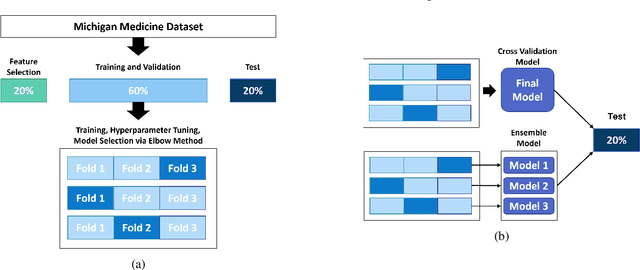
Abstract:Oral Food Challenges (OFCs) are essential to accurately diagnosing food allergy in patients. However, patients are hesitant to undergo OFCs, and for those that do, there is limited access to allergists in rural/community healthcare settings. The prediction of OFC outcomes through machine learning methods can facilitate the de-labeling of food allergens at home, improve patient and physician comfort during OFCs, and economize medical resources by minimizing the number of OFCs performed. Clinical data was gathered from 1,112 patients who collectively underwent a total of 1,284 OFCs, and consisted of clinical factors including serum specific IgE, total IgE, skin prick tests (SPTs), symptoms, sex, and age. Using these clinical features, machine learning models were constructed to predict outcomes for peanut, egg, and milk challenge. The best performing model for each allergen was created using the Learning Using Concave and Convex Kernels (LUCCK) method, which achieved an Area under the Curve (AUC) for peanut, egg, and milk OFC prediction of 0.76, 0.68, and 0.70, respectively. Model interpretation via SHapley Additive exPlanations (SHAP) indicate that specific IgE, along with wheal and flare values from SPTs, are highly predictive of OFC outcomes. The results of this analysis suggest that machine learning has the potential to predict OFC outcomes and reveal relevant clinical factors for further study.
A Novel Tropical Geometry-based Interpretable Machine Learning Method: Application in Prognosis of Advanced Heart Failure
Dec 09, 2021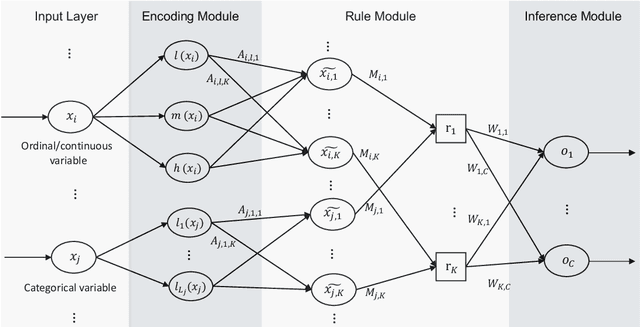
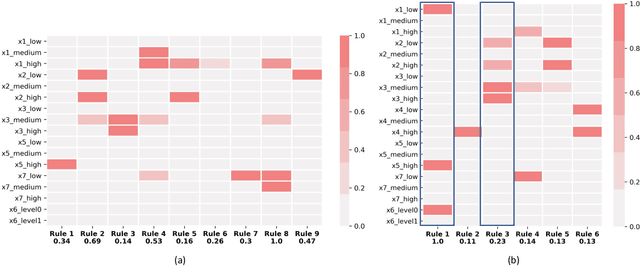
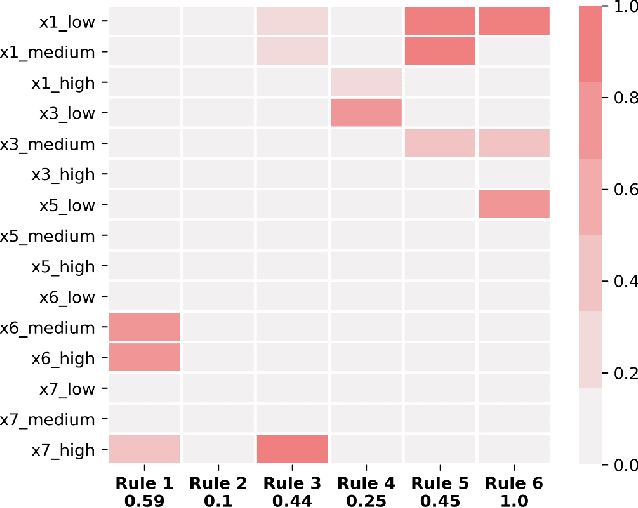
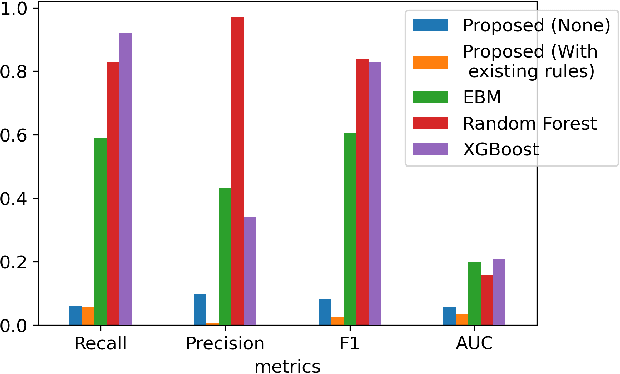
Abstract:A model's interpretability is essential to many practical applications such as clinical decision support systems. In this paper, a novel interpretable machine learning method is presented, which can model the relationship between input variables and responses in humanly understandable rules. The method is built by applying tropical geometry to fuzzy inference systems, wherein variable encoding functions and salient rules can be discovered by supervised learning. Experiments using synthetic datasets were conducted to investigate the performance and capacity of the proposed algorithm in classification and rule discovery. Furthermore, the proposed method was applied to a clinical application that identified heart failure patients that would benefit from advanced therapies such as heart transplant or durable mechanical circulatory support. Experimental results show that the proposed network achieved great performance on the classification tasks. In addition to learning humanly understandable rules from the dataset, existing fuzzy domain knowledge can be easily transferred into the network and used to facilitate model training. From our results, the proposed model and the ability of learning existing domain knowledge can significantly improve the model generalizability. The characteristics of the proposed network make it promising in applications requiring model reliability and justification.
Motion-based Camera Localization System in Colonoscopy Videos
Dec 04, 2020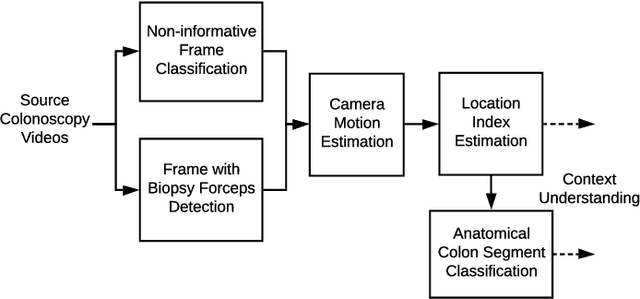

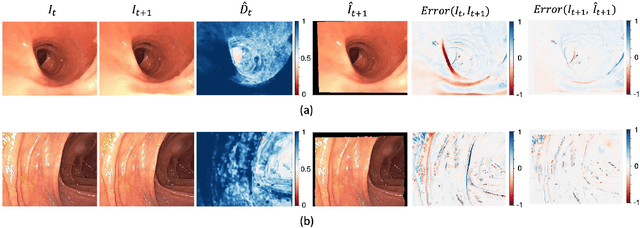

Abstract:Optical colonoscopy is an essential diagnostic and prognostic tool for many gastrointestinal diseases including cancer screening and staging, intestinal bleeding, diarrhea, abdominal symptom evaluation, and inflammatory bowel disease assessment. However, the evaluation, classification, and quantification of findings on colonoscopy are subject to inter-observer variation. Automated assessment of colonoscopy is of interest considering the subjectivity present in qualitative human interpretations of colonoscopy findings. Localization of the camera is an essential element to consider when inferring the meaning and context of findings for diseases evaluated by colonoscopy. In this study, we proposed a camera localization system to estimate the approximate anatomic location of the camera and classify the anatomical colon segment the camera is in. The camera localization system starts with non-informative frame detection to remove frames without camera motion information. Then a self-training end-to-end convolutional neural network was built to estimate the camera motion. With the estimated camera motion, the camera trajectory can be derived, and the location index can be calculated. Based on the estimated location index, anatomical colon segment classification was performed by building the colon template. The algorithm was trained and validated using colonoscopy videos collected from routine clinical practice. From our results, the average accuracy of the classification is 0.759, which is substantially higher than the performance of using the location index built from other methods.
An Unsupervised Feature Learning Approach to Reduce False Alarm Rate in ICUs
Apr 17, 2019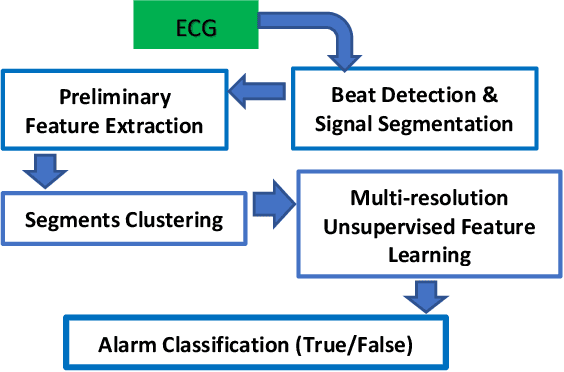

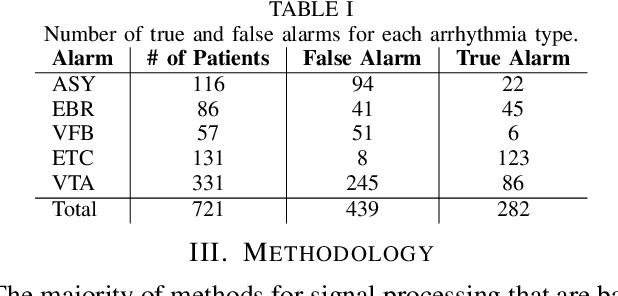
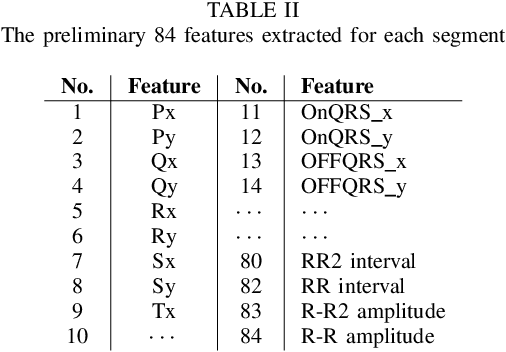
Abstract:The high rate of false alarms in intensive care units (ICUs) is one of the top challenges of using medical technology in hospitals. These false alarms are often caused by patients' movements, detachment of monitoring sensors, or different sources of noise and interference that impact the collected signals from different monitoring devices. In this paper, we propose a novel set of high-level features based on unsupervised feature learning technique in order to effectively capture the characteristics of different arrhythmia in electrocardiogram (ECG) signal and differentiate them from irregularity in signals due to different sources of signal disturbances. This unsupervised feature learning technique, first extracts a set of low-level features from all existing heart cycles of a patient, and then clusters these segments for each individual patient to provide a set of prominent high-level features. The objective of the clustering phase is to enable the classification method to differentiate between the high-level features extracted from normal and abnormal cycles (i.e., either due to arrhythmia or different sources of distortions in signal) in order to put more attention to the features extracted from abnormal portion of the signal that contribute to the alarm. The performance of this method is evaluated using the 2015 PhysioNet/Computing in Cardiology Challenge dataset for reducing false arrhythmia alarms in the ICUs. As confirmed by the experimental results, the proposed method offers a considerable performance in terms of accuracy, sensitivity and specificity of alarm detection only using a few high-level features that are extracted from one single lead ECG signal.
Solving the Conjugacy Decision Problem via Machine Learning
Feb 21, 2018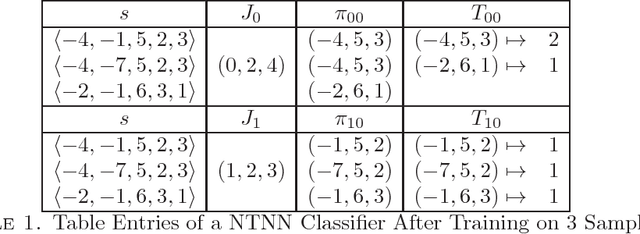



Abstract:Machine learning and pattern recognition techniques have been successfully applied to algorithmic problems in free groups. In this paper, we seek to extend these techniques to finitely presented non-free groups, with a particular emphasis on polycyclic and metabelian groups that are of interest to non-commutative cryptography. As a prototypical example, we utilize supervised learning methods to construct classifiers that can solve the conjugacy decision problem, i.e., determine whether or not a pair of elements from a specified group are conjugate. The accuracies of classifiers created using decision trees, random forests, and N-tuple neural network models are evaluated for several non-free groups. The very high accuracy of these classifiers suggests an underlying mathematical relationship with respect to conjugacy in the tested groups.
 Add to Chrome
Add to Chrome Add to Firefox
Add to Firefox Add to Edge
Add to Edge